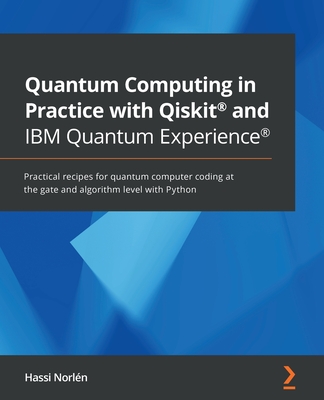A Practical Guide to Quantum Computing: Hands-on approach to quantum computing with Qiskit
暫譯: 量子計算實用指南:使用 Qiskit 的實作方法
Combarro, Elías F., González-Castillo, Samuel, Sertage, Ismael Faro
- 出版商: Packt Publishing
- 出版日期: 2025-07-30
- 售價: $1,640
- 貴賓價: 9.5 折 $1,558
- 語言: 英文
- 頁數: 512
- 裝訂: Quality Paper - also called trade paper
- ISBN: 1835885942
- ISBN-13: 9781835885949
-
相關分類:
量子計算
立即出貨 (庫存 < 3)
相關主題
商品描述
Learn about quantum information processing with Qiskit through hands-on projects. A foundational resource for STEM professionals, researchers and university students interested in quantum computers and algorithms
Key Features:
- Understand the theoretical foundations of quantum computing
- Learn how to use the Qiskit framework and how to run quantum algorithms with it
- Discover top quantum algorithms like Grover's search and Shor's factoring methods
- Purchase of the print or Kindle book includes a free PDF eBook
Book Description:
This book is an introduction, from scratch, to quantum computing and the most important and foundational quantum algorithms-ranging from humble protocols such as Deutsch's algorithm to ones with far-reaching potential, such as Shor's factoring algorithm-offering clear explanations and a hands-on approach with runnable code on simulators and real hardware. The book is self-contained and does not assume any previous experience in quantum computing. Starting with a single qubit, it scales to algorithms using superposition and entanglement.
At every step, examples of applications are provided, including how to create quantum money that is impossible to forge, quantum cryptography that cannot be broken, and algorithms for searching and factoring that are much faster than those that regular, non-quantum computers can use. Code for each of these algorithms is provided (and explained in detail) using Qiskit 2.1.
After reading this book, you will understand how quantum algorithms work, how to write your own quantum programs, and how to run them on quantum simulators and actual quantum computers. You will also be prepared to take the jump into quantum algorithms for optimization and artificial intelligence, like those presented in our previous book, A Practical Guide to Quantum Machine Learning and Quantum Optimization.
What You Will Learn:
- Understand what makes a quantum computer unique
- Mathematically represent the state of multi-qubit systems
- Describe the effects of measurements in quantum computers
- Know how quantum superposition, entanglement, and interference work
- Implement and run any quantum algorithm in Qiskit
- Understand how Shor's and Grover's algorithms work
- Gain familiarity with quantum fault-tolerance and quantum advantage
Who this book is for:
This book would be ideal for university-level students in Computer Science, Mathematics, Physics or other STEM fields taking introductory-level courses on quantum computing. It also suits professionals, researchers and self-learners with a STEM background. Potential readers of our previous book, A Practical Guide to Quantum Machine Learning and Quantum Optimization, will benefit from first building foundational quantum computing skills with this book.
Table of Contents
- What Is (and What Is Not) a Quantum Computer?
- Qubits, Gates, and Measurements
- Applications and Protocols with One Qubit
- Coding One-Qubit Protocols in Qiskit
- How to Work with Two Qubits
- Applications and Protocols with Two Qubits
- Coding Two-Qubit Algorithms in Qiskit
- How to Work with Many Qubits
- The Full Power of Quantum Algorithms
- Coding with Many Qubits in Qiskit
- Finding the Period and Factoring Numbers
- Searching and Counting with a Quantum Computer
- Coding Shor and Grover's Algorithms in Qiskit
- Quantum Error Correction and Fault Tolerance
- Experiments for Quantum Advantage
- APPENDICES
商品描述(中文翻譯)
學習如何透過實作專案使用 Qiskit 進行量子資訊處理。這是一本為對量子電腦和演算法感興趣的 STEM 專業人士、研究人員和大學生提供的基礎資源。
主要特點:
- 理解量子計算的理論基礎
- 學習如何使用 Qiskit 框架及如何運行量子演算法
- 探索像是 Grover 搜尋和 Shor 分解方法等頂尖量子演算法
- 購買印刷版或 Kindle 版書籍可獲得免費 PDF 電子書
書籍描述:
本書是從零開始介紹量子計算及最重要和基礎的量子演算法,涵蓋從簡單的協議(如 Deutsch 演算法)到具有深遠潛力的演算法(如 Shor 分解演算法),提供清晰的解釋和可在模擬器及實際硬體上運行的實作方法。本書是自足的,並不假設讀者有任何量子計算的先前經驗。從單一量子位(qubit)開始,逐步擴展到使用疊加和糾纏的演算法。
在每一步中,提供應用範例,包括如何創建無法偽造的量子貨幣、無法破解的量子密碼學,以及比傳統非量子電腦更快的搜尋和分解演算法。每個演算法的程式碼都提供(並詳細解釋),使用 Qiskit 2.1。
閱讀本書後,您將理解量子演算法的運作方式,如何編寫自己的量子程式,以及如何在量子模擬器和實際量子電腦上運行它們。您還將準備好進入優化和人工智慧的量子演算法領域,如我們之前的書籍《量子機器學習與量子優化實用指南》中所介紹的內容。
您將學到的內容:
- 理解量子電腦的獨特之處
- 用數學表示多量子位系統的狀態
- 描述量子電腦中測量的影響
- 知道量子疊加、糾纏和干涉的運作方式
- 在 Qiskit 中實作和運行任何量子演算法
- 理解 Shor 和 Grover 演算法的運作方式
- 熟悉量子容錯和量子優勢
本書適合對象:
本書非常適合大學層級的計算機科學、數學、物理或其他 STEM 領域的學生,特別是修習量子計算入門課程的學生。它也適合具有 STEM 背景的專業人士、研究人員和自學者。對我們之前的書籍《量子機器學習與量子優化實用指南》的潛在讀者,將能夠透過本書先建立基礎的量子計算技能。
目錄:
- 什麼是(以及什麼不是)量子電腦?
- 量子位、閘和測量
- 單量子位的應用和協議
- 在 Qiskit 中編碼單量子位協議
- 如何處理兩個量子位
- 雙量子位的應用和協議
- 在 Qiskit 中編碼雙量子位演算法
- 如何處理多個量子位
- 量子演算法的全部威力
- 在 Qiskit 中使用多個量子位編碼
- 尋找周期和分解數字
- 使用量子電腦進行搜尋和計數
- 在 Qiskit 中編碼 Shor 和 Grover 的演算法
- 量子錯誤修正和容錯
- 量子優勢的實驗
- 附錄












